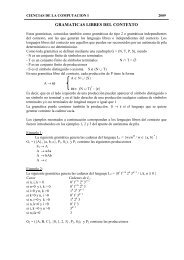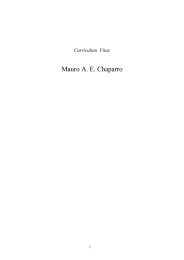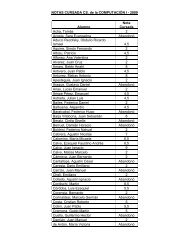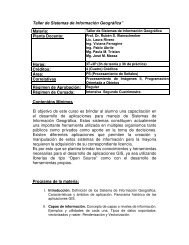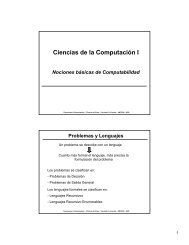Libro de Resúmenes / Book of Abstracts (Español/English)
Libro de Resúmenes / Book of Abstracts (Español/English)
Libro de Resúmenes / Book of Abstracts (Español/English)
Create successful ePaper yourself
Turn your PDF publications into a flip-book with our unique Google optimized e-Paper software.
Resumenes 87<br />
An important part <strong>of</strong> a population’s environment is the presence <strong>of</strong><br />
populations <strong>of</strong> different species with which the first coexists. This implies<br />
that evolutionary changes in a species may lead to evolution in another<br />
species with which it interacts. When such changes occur reciprocally<br />
between two species, there is coevolution. This work evaluates coevolution<br />
in a predator-prey system given by a Lotka-Volterra mo<strong>de</strong>l, whose<br />
parameters are functions <strong>of</strong> individual traits and are subject to modification<br />
by natural selection. Both species are supposed to <strong>de</strong>dicate all their energy<br />
to survival, reproduction and producing traits that intensify or attenuate<br />
predation pressure. The prey’s net energy is constant, while the predator’s<br />
<strong>de</strong>pends on the prey capture rate, which requires investment. This tra<strong>de</strong><strong>of</strong>f<br />
affords the link for evaluating the coevolution <strong>of</strong> life histories between<br />
predator and prey. The mo<strong>de</strong>l intends to answer, using the Theory <strong>of</strong><br />
Evolutionary Games, how the investment in predation-related traits in one<br />
<strong>of</strong> the antagonists influences the evolutionary stable strategy <strong>of</strong> energy<br />
allocation among traits <strong>of</strong> the life history <strong>of</strong> the other species when only one<br />
is subject to evolution, and whether the evolutionary dynamics differs when<br />
consi<strong>de</strong>ring coevolution.<br />
Results indicate that when only one <strong>of</strong> the antagonists’ evolution is<br />
consi<strong>de</strong>red, each <strong>of</strong> them reaches the Evolutionary Stable Strategy. In the<br />
prey, investment in <strong>de</strong>fence is directly proportional to investment in attackrelated<br />
traits in the predator, while this last <strong>de</strong>sists when the prey increases<br />
its <strong>de</strong>fences. The equilibrium point in this system is unstable, because<br />
evolution in the prey causes the dynamics to move away from the<br />
equilibrium point, while evolution in the predator causes it to move towards<br />
it, producing an evolutionary saddle. When the possibility <strong>of</strong> simultaneous<br />
adaptations is consi<strong>de</strong>red, the equilibrium point remains unstable, but<br />
evolutionary variables show a stable cyclic behaviour which is continued<br />
in<strong>de</strong>finitely, leading to a Red Queen dynamics. Thus, the effect <strong>of</strong><br />
coevolution in this system is stabilizing.<br />
Feedback between the predator’s energy budget and that <strong>of</strong> the<br />
prey’s, which constitutes the original trait <strong>of</strong> the mo<strong>de</strong>l, is the supposition<br />
which allows the stabilizing effect <strong>of</strong> the predator’s evolution, responsible<br />
for the instability <strong>of</strong> the equilibrium point and, therefore, <strong>of</strong> the oscillation <strong>of</strong><br />
the evolutionary traits in a limit cycle.



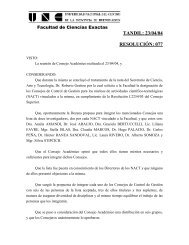
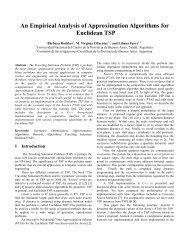
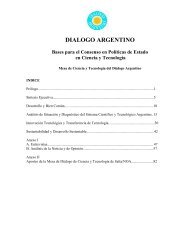
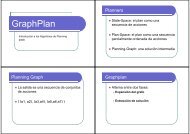
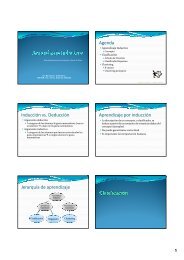
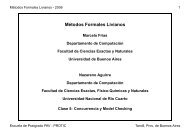
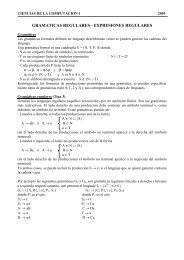
![Clase 13 [pdf]](https://img.yumpu.com/19616969/1/190x245/clase-13-pdf.jpg?quality=85)


